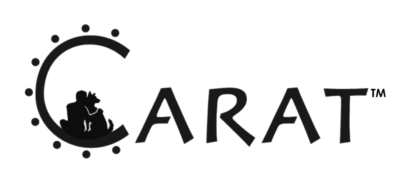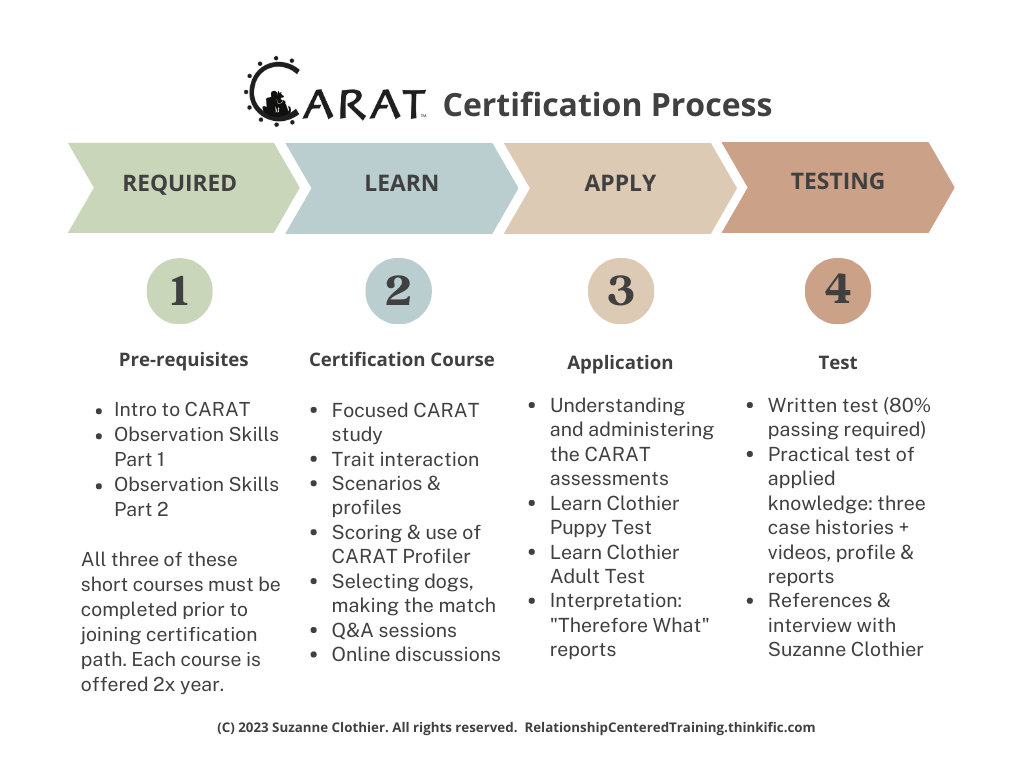
CARAT
Ethology of the Individual
Understanding Temperament: Each Dog’s Characteristic Responses
Each animal has a typical way of reacting to the world. The preferred, first and most natural way of reacting is known as temperament.
CARAT changes everything! This assessment tool creates a detailed profile of the individual dog as a unique combination of many traits working together to influence, exacerbate, mitigate and enhance each other.
Temperament is a complex interaction of genetics, environmental influences and experience that all combine to create the individual. Some temperament traits prove to be “hard wired” and persistent across the dog’s lifespan, with their expression changed perhaps only by age and health status. Other traits reveal themselves to be influenced by learning, environment, relationships, and experience to varying degrees.
What Makes CARAT Different
CARAT is not a test. There is no PASS or FAIL. CARAT is a scoring system, based on observable behaviors and patterns of response, with the goal of creating a profile for an individual animal.
Unlike temperament assessment systems that inaccurately lump together many different traits, CARAT differentiates a dog that is stressed and demonstrating avoidance sniffing from a dog that is confident but visually distracted by birds. In another rating system, they may have the same distraction score.
The dog’s individual profile is expressed in a nuanced graphic profile that – to someone who knows CARAT – tells a detailed story.
About the Developer
CARAT was first presented by Suzanne Clothier in 2007 and has been refined through nearly two decades of practical application with thousands of dogs across diverse contexts. Suzanne brings decades of experience in canine behavior, training, and assessment, with her work focusing on understanding dogs as individuals through the lens of Relationship Centered Training—emphasizing the importance of seeing each dog’s unique behavioral patterns and responses.
The Science of the CARAT Scale
CARAT scoring uses a bi-directional scale where the mid-point score of 0 is the balanced, highly functional and adaptive behavior. As the score heads towards the left or the right, the behavior becomes increasingly less adaptive, though it may become desirable within a specific niche. Think of an intensely olfactory dog who has a job as a narcotics detection dog – ideal in that lifestyle, might make a companion dog owner crazy with how much the dog insists on using their nose.
Adaptive behavior is flexible, and allows the individual to effectively meet demands of social responsibility, personal independence and environmental expectations. And to do so in multiple contexts, across various environments.
The Left Shift is a tendency towards inhibition, passive, suppression and/or avoidant behavior.
The Right Shift is a tendency toward activation, irritation, excitability and/or aggression.
The CARAT scale is an exponential scale, not a strictly linear scale. Because CARAT is based on functional, adaptive behavior, the shift from adaptive to dysfunction is precipitous, not gradual. The step from 0 to -1 or +1 is much more moderate than the step from 2 to 3, and the step from 3 to 4 is much greater.
As behavior moves closer to either extreme, it becomes more specialized, less broadly functional. Temperament scores on either extreme of +4 or -4 are unproductive for that trait, meaning that this behavior is not adaptive, and is more rigid, less flexible behavior.
Interactive CARAT Behavioral Scale
Hover over each number to see behavioral descriptions
The center point (0) represents highly functional, adaptive behavior
RIGHT SHIFT: Activation, Excitability, Aggression →
-4
-3
-2
-1
0
+1
+2
+3
+4
CARAT uses an exponential scale – the difference between +2 and +3 is much greater than between 0 and +1.
The CARAT Traits
CARAT traits are behavioral responses reduced to their simplest motivation or expression. This detailed approach avoids the “big bucket” labels which are actually confounded traits that may or may not actually appear in one specific relation to another.
Core Traits
These traits appear to be “hard wired” and not particularly mutable:
- Arousal: Physiological response to stimuli
- Resilience: Speed of recovery to baseline after arousal
- Energy: Physical activity level (motor movements)
Social Traits
These traits reflect the dog as a social being in relationship to people:
- Sociability: Interest in interactions with people
- Social Tolerance: Acceptance of rude or inappropriate interactions
- Use of Space: How dog uses body and movements in interactions
Interactive Traits
These traits are specifically related to how the dog interacts with people:
- Patience: Response to lack of information/guidance
- Biddability (with familiar person): Willingness to work with known handler
- Biddability (with stranger): Willingness to work with unfamiliar person
Awareness Traits
These traits reflect the dog’s sensory processes:
- Visual Awareness
- Auditory Awareness
- Kinesthetic Awareness
- Olfactory Awareness
Persistence Traits
These traits reflect the dog’s focus on various stimuli:
- Visual Persistence
- Auditory Persistence
- Kinesthetic Persistence
- Olfactory Persistence
- Predatory/Chase Persistence
Complex Traits
Complex traits reflect the interaction of and influence of many factors. These are scored on a simple 5 point scale, with 5 defining the highest possible score:
- Social Confidence: Assurance, sureness in social settings
- Environmental Confidence: Absence of non-social fear
- Self Modulation: Ability to spontaneously self regulate state of arousal appropriate to context without external prompts or assistance
Understanding Through Assessment
The assessment environment serves a specific purpose: to provoke the patterns of response that are evidenced by observable behavior. Observable behavior that can be accurately described in detail is the key to a useful assessment.
An assessment can only be done when a situation puts the dog under pressure in order to determine strength or fragility, flexibility and adaptability versus rigidity or inflexibility of behavior.
Let’s pretend for a moment that we paint some plywood so it looks like teak. No matter how good it looks, in heavy rain, interior grade plywood delaminates and falls apart. Real teak sheds water – that is a foundational characteristic of teak wood. We understand that plywood cannot withstand the same rain. Yet when we talk about dogs and temperament, we can end up blaming the rain and not the characteristics of plywood: “If only the rain hadn’t fallen so hard and so heavy, the plywood would have held up just fine!”
Truth is, the interior grade plywood is only fine under a fairly limited set of circumstances, and it goes to pieces and loses integrity rapidly under other conditions. Teak, on the other hand, maintains tremendous integrity under a wide range of circumstances. Likewise, a dog’s temperament tells us about their characteristic responses and what they can – and cannot – handle, what they can and cannot do well, where they are adaptable and functional and where they need support.
When we SEE THE DOG – understand in detail who a dog really is – we are well positioned to do right for that dog, with that dog.
Who Benefits from CARAT?
CARAT offers a comprehensive approach to assessing and understanding behavior. It is a tool that is valuable for:
Trainers & Instructors: Creating effective, humane training plans based on individual response patterns
Shelter/Rescue/ACO Personnel: Making informed placement decisions and understanding behavioral needs
Veterinarians & Vet Techs: Understanding behavioral components of health and wellness
Behaviorists: Developing intervention strategies based on detailed temperament profiles
Competitors & Handlers: Identifying dogs whose profiles align with specific activities
Breeders: Evaluating breeding stock and guiding puppy placement decisions
Service & Working Dog Programs: Identifying suitable candidates and creating profile of desirable traits for best performance
Ethologists/Biologists: Utilizing standardized behavioral data for research
The Power of Individual Understanding
CARAT helps to delineate what makes one individual dog suitable for a task while another dog is not. For example, a competitive tracking dog ideally has a productive, heightened olfactory awareness with a higher level of olfactory persistence. A successful guide dog is visually aware, and does not have any notable olfactory persistence.
The goal is to define what role might be most suitable for this dog, what lifestyle might be most comfortable for this individual, what type of person might be most compatible with this dog, and what situations or handlers or demands might be unfair, distressing or unproductive for this individual.
Overall profiles or specific scores on specific traits may represent serious deficits in adaptive behavior. For that individual dog, this may mean that the animal may require extensive support through management, environmental control and/or training to ensure quality of life.
These are the CARAT profiles for 3 littermates. All are Labradors, purpose-bred at at service dog organization. Notice the variation between them!

CARAT provides the tools to see clearly, assess accurately, and respond appropriately to the magnificent complexity of canine temperament. Through CARAT, we move beyond assumptions and generalizations to embrace the truth: every dog has their own story written in behavior, waiting for someone skilled enough to read it.
Ready to Explore CARAT?
Find a Certified CARAT Assessor to have your dog professionally evaluated.
Register for the Intro to CARAT Course to develop your own assessment skills.
DISCOVER MORE ABOUT CARAT CERTIFICATION


